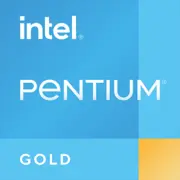Intel Pentium Gold G6505T

Intel Pentium Gold G6505T: Processore Economico per Compiti di Base nel 2025
(Aprile 2025)
Caratteristiche Principali: Architettura e Prestazioni
Il processore Intel Pentium Gold G6505T, lanciato nella serie Comet Lake (2020), rimane rilevante nel 2025 grazie al suo basso consumo energetico e al prezzo accessibile.
- Architettura e Processo Tecnologico: Tecnologia a 14 nm (3ª generazione di Intel 14nm++), 2 core, 4 thread (Hyper-Threading). Frequenza — 3.6 GHz (senza Turbo Boost).
- Cache e Grafica: Cache L3 di 4 MB, GPU integrata Intel UHD Graphics 630 (frequenza base 350 MHz, massima — 1.05 GHz).
- TDP: 35 W — ideale per sistemi compatti.
Caratteristiche Chiave:
- Supporto 4K tramite HDMI 1.4 e DisplayPort 1.2.
- Tecnologie Intel Quick Sync Video (accelerazione della codifica video) e AES-NI (crittografia dei dati).
- Compatibilità con Windows 11 e distribuzioni Linux.
Prestazioni:
Nei test Cinebench R23, il processore ottiene circa 2200 punti (monotasking — ~1000). A titolo di confronto: l’AMD Athlon 3000G (2/4) mostra risultati simili, ma è meno efficiente dal punto di vista energetico.
Schede Madri Compatibili
Socket: LGA 1200.
Chipset:
- H410/B460/H470: Scelta economica per PC da ufficio (H410 — da $60).
- Z490/Z590: Per appassionati che vogliono connettere NVMe PCIe 4.0 (ma la CPU non supporta PCIe 4.0).
Raccomandazioni:
- Per una configurazione base: ASRock H410M-HDV ($65).
- Per un upgrade: MSI B460M PRO-VDH WiFi ($90) con supporto per Wi-Fi 6.
Importante: Dopo il 2023, molte schede LGA 1200 sono state dismesse, ma disponibili sul mercato secondario. Quando acquistate una scheda nuova, verificate la compatibilità con il BIOS versione P4.20 e superiore.
Memoria Supportata
- Tipo: DDR4-2666 MHz (ufficiale).
- Configurazioni: Fino a 128 GB (2 canali, 2 slot nella maggior parte delle schede).
Suggerimenti:
- Capacità ottimale: 8–16 GB (ad esempio, kit Crucial DDR4-2666 16GB — $45).
- Evitate DDR5: la CPU e i chipset LGA 1200 non supportano il nuovo standard.
Alimentatori: Calcolo e Raccomandazioni
Con un TDP di 35 W, anche un alimentatore da 300 W è sufficiente, ma è importante considerare le periferiche:
- Senza scheda video dedicata: EVGA 400W 80+ (≈$35).
- Con GPU di livello GTX 1650: Thermaltake Smart 500W 80+ Bronze ($50).
Regola: Per sistemi con Pentium Gold G6505T + GPU, allocate 150–200 W per la scheda video e 50–100 W per gli altri componenti.
Pro e Contro
Pro:
- Efficienza energetica: Un PC basato su questa CPU può essere assemblato senza raffreddamento attivo.
- Prezzo: Il nuovo processore costa $75–85 (aprile 2025).
- Grafica integrata: Adatta per video 4K e giochi leggeri (CS:GO, Dota 2 a impostazioni basse).
Contro:
- 2 core: Multitasking limitato (ad esempio, streaming su Twitch + gioco — non possibile).
- Processo tecnologico obsoleto: Ryzen 3 5300G (6 nm) è il 30% più veloce in compiti multi-thread.
Scenari d’Uso
1. Compiti d’ufficio: Lavoro con documenti, browser (10+ schede), conferenze Zoom.
2. Multimedia: Visione di video 4K, streaming Netflix, lavoro con foto (Lightroom).
3. Giochi Leggeri: Minecraft, Genshin Impact (720p, impostazioni basse), emulatori retro.
Esempio Reale:
Un utente ha assemblato un HTPC (centro multimediale domestico) con Pentium G6505T + 8 GB di RAM + SSD da 256 GB. Il sistema consuma 25 W in idle, esegue Plex Media Server e 4K HDR senza lag.
Confronto con i Competitori
1. AMD Athlon 3000G ($60):
- Pro: Grafica Vega 3 più potente della UHD 630.
- Contro: Nessun supporto PCIe 3.0 x16.
2. Intel Celeron G5925 ($50):
- Pro: Più economico.
- Contro: Nessun Hyper-Threading, frequenza 3.6 GHz.
3. Ryzen 3 5300G ($120):
- Pro: 4 core/8 thread, Radeon Vega 6.
- Contro: Prezzo e TDP più elevati (65 W).
Consigli Pratici per l’Assemblaggio
1. Case: Scegliete case Mini-ITX compatti (Cooler Master Elite 110 — $50).
2. Raffreddamento: Il cooler box è sufficiente, ma per un funzionamento silenzioso — Noctua NH-L9i ($45).
3. Storage: SSD essenziale (Kingston A400 480GB — $35).
4. Opzioni di rete: Aggiungete una scheda Wi-Fi PCIe (TP-Link Archer TX50E — $40), se la scheda madre non ha un modulo.
Errori Comuni nell’Assemblaggio:
- Installazione di DDR4-3200: La CPU è limitata a 2666 MHz.
- Acquisto di una scheda madre costosa: Z590 è eccessiva per questa CPU.
Conclusione: A Chi Si Adatta il Pentium Gold G6505T?
Questo processore è la scelta ideale per:
- Utenti con Budget Limitato: Assemblaggio di un PC da $250–350.
- Postazioni di Lavoro Ufficio: Affidabilità e basso consumo energetico.
- Appassionati di DIY: Creazione di centri multimediali silenziosi o router basati su PC.
Perché nel 2025?
Nonostante l’età, il G6505T rimane uno dei CPU più accessibili con supporto 4K e Hyper-Threading. Se non avete bisogno di giochi moderni o rendering, offre un’ottima relazione qualità-prezzo.
I prezzi sono aggiornati ad aprile 2025. Sono indicati per dispositivi nuovi nei negozi al dettaglio degli Stati Uniti.
Di base
Specifiche della CPU
Specifiche della memoria
Specifiche della GPU
Varie
Classifiche
Rispetto ad altre CPU
Condividi sui social media
Oppure linkaci
<a href="https://cputronic.com/it/cpu/intel-pentium-gold-g6505t" target="_blank">Intel Pentium Gold G6505T</a>